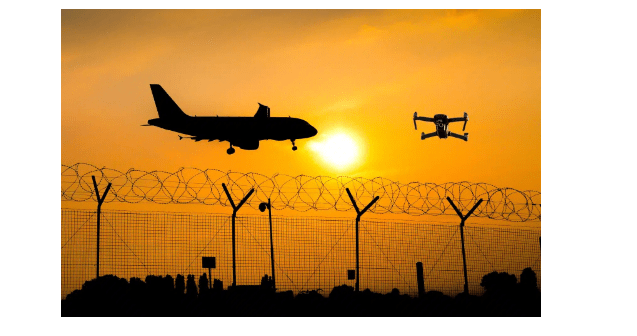Safeguard Your Property and Assets with Drone Detection Systems

With the increasing popularity of drones and their increasing availability, it has become more crucial than ever to safeguard your organization or home from unwanted drone intrusions. Drone spying is a serious threat that can compromise your privacy and security.
Fortunately, there are several drone detection technologies available that can help you protect your property from drone intrusions. These technologies can be used to patrol and secure your privacy from wandering drones. Whether it is new or old technology, these detection systems can be implemented to ensure that your property and assets remain safe from drone-related threats.
Understanding Drone Detection: Meaning and Importance
Drone detection technology refers to the use of various technologies to detect drones or other unmanned aircraft systems (UAS) flying in the air. Previously, this technology was primarily used by governments and highly secured areas, but it is now becoming more widely available for businesses and personal properties.
There are various types of technologies used for detecting drones, and they differ in terms of their range and the size of drones they can detect. For instance, RF sensors detect drones using RF communication, while visual technologies can confirm the presence of a drone in the area.
When selecting a drone detection system for your company or home, it is essential to evaluate the capabilities of each technology. Large businesses with extensive surveillance needs and significant security budgets may require different drone detection systems than a local farm. Conducting thorough research and understanding the capabilities of each technology is crucial to selecting the best drone detection system for your needs.
The Importance of Drone Detection

Although some drones are just used for hobbyists to capture photographs or video, drones can be weaponized to spy and conduct nefarious actions. Drones that are found in no-fly zones can pose a risk to airports, gas facilities, and prisons. If a drone, even just a hobby drone, is found flying near an airport, the airport will have to pause traffic in order to ensure everyone’s safety.
Due to its speed, size, and ability to carry items such as contraband, chemicals, or even explosives, drones have the potential to cause untold damage to crowds and buildings. In order to protect these areas and the airspace, drone detection is needed.
Benefits of drone detection
Although prisons, secured facilities, and airports are prime types of organizations that require drone detection, almost any type of business or even city can benefit from drone detection technology.
Drone detection can help organizations:
Detect drones and their pilots
Alert security teams about the model of the drone, location, and altitude
Provide alerts that can help improve overall security
Allow for real-time interventions to prevents disasters
Record drones for evidence in the future
Types of Drone Detection Technologies

Many types of solutions and technologies have been developed to detect drones. Security teams can use these solutions to find the location of a drone, the type of drone, speed, and in some instances, where the pilot of the drone is located through GPS.
RF frequency drone detection
Many drones rely on RF frequencies to communicate with the pilot. The receiver and transmitter are paired together with RFID chips that keep other devices from taking over the drone. With RD frequency drone detection, sensors listen and monitor frequencies to determine the location of the drone in the area.
Radar drone detection
Radar is an excellent tool for detecting drones in the area. It scans the sky to find reflections to detect movement and size of objects and then compares it to its database of drones to match it. Some systems will also be able to detect other objects that are not drones, such as birds, and ignore them. The downside of radar, however, is if a drone is not in the database or looks strange, it may not be detected.
Visual tracking
Specific cameras, PTZ cameras, that are able to swivel and track movements can be used for drone detection when used with other technology, such as radar. Visual tracking is helpful to capture the actual image of the drone in the area and confirm that it’s there, what type of drone it is, and if it presents a threat. Since it’s a visual medium, weather can impact the accuracy of the camera and shouldn’t be used as the first line of defense in drone detection.
Acoustic sensors
Those who want to test out drone detection for their homes can try using microphones or other acoustic sensors placed around their property. Microphones can detect the sounds of drones and can help you calculate a direction. The downside to a microphone is that they can only be used in short ranges and quiet areas, such as a farm or wooded area, otherwise there will be too much noise interference to detect the drones properly.
Choosing the Best Drone Detection
When it comes to finding the right solution to detect drones for your business or facility, there are a number of factors to consider, including your budget, time, layout, and overall security needs.
For example, if you have a large area to cover, RF sensors would be a good starting point, as they cover a range of 1-10 miles. RF sensors are often the first line of defense to drone detection as most drones rely on the technology and it can be relatively inexpensive to begin with.
However, if you have a highly secured facility, such as a prison or government building, a combination of drone detection technologies is the best option. While RF sensors can detect most drones, there may be ones that slip through undetected that a radar will be able to find.
Other factors to consider when looking for the best drone detection system are:
Is this the best system for your environment; including noise, light, buildings, and more?
Is the system operational 24/7?
Does the system detect multiple drones at the same time?
Can the system detect different types of drones, or is it limited to what the manufacturer has set in its programming?
Differentiating Drone Detection and Drone Countermeasures
Drone detection is used for the surveillance of property and land to alert owners that there is a drone nearby. From there, decisions can be made to leave the drone alone or investigate it further.
Drone countermeasure refers to what is actually done to the drone once it has been identified as a threat. Countermeasures to drones are limited by government regulations and can only be done by the military or law enforcement. Those in the military or law enforcement use a few different counter-drone technologies, similar to drone detection systems, to prevent drones that are threats from conducting their action.
These countermeasure technologies include:
Radio Frequency Jammers – RF jammers emit a large amount of RF energy at unknown drones to mask the controlling signal, which forces a drone to either land, return to its pilot, fall, or fly in a random direction. RF signals can be a static system at a security center or handheld devices taken into the field.
GPS Spoofers – GPS spoofers are used to send a new signal to the drone which interrupts its navigation systems and “tricks” the drone into thinking its location is different. These are helpful in getting a drone to a different, safer location, such as away from an airport and near a secured area for inspection.
Net Cannon – Although you might picture a cartoon shooting a net out of a cannon by mistake, net cannons are helpful in capturing drones. They can be launched from the ground or even shot by another drone in the air. By capturing a drone, the drone can be investigated and used for prosecution if needed.
HPM Devices – HPM devices, or high power microwave devices, create an electromagnetic pulse that can disrupt electrical devices by interfering with radio links, or if it’s especially powerful, destroying the circuitry in the drone and other devices nearby. HPM devices have a high cost and risk associated with them and are used as more of a last resort for drone countermeasure.
Actions to Take When a Drone is Detected Flying Over Private Property
It is essential to note that using countermeasures against drones is restricted to the military and law enforcement agencies. Civilians should not interfere with a drone, even if it is flying over their property or in restricted airspace. Shooting down a drone is a violation of US code 34, which protects aircraft from damage.
If a suspicious drone is flying above your property, it is advisable to approach the drone owner, if possible. The drone operator might be your neighbor or a child playing with a drone. You can discuss the issue with them and ask if they can fly the drone somewhere else.
However, if the drone continues to fly over your property or behaves erratically, it is advisable to report it to the authorities or FAA for further investigation. Record the drone as evidence, and the authorities can determine if the drone is violating any regulations or posing a threat to privacy or security.
Protect your Privacy with Drone Detection Technology
While civilians have limited options for drone countermeasures, they can benefit from using drone detection technology. Drone detection systems are useful in tracking and identifying drones flying in the vicinity to determine if it’s a harmless hobbyist or a potential security threat. If you have a secure facility, sensitive information, or a business, it is even more important to use drone detection technology to protect your privacy and prevent unauthorized surveillance. By incorporating drone detection systems, you can reduce the risk of spying and ensure the safety and security of your property and information.








